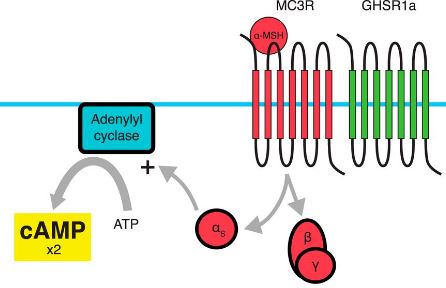Hi-Affi™ MCR3 Stable Cell Line
G protein coupled-receptors (GPCRs) represents the largest and most versatile group of cell surface receptors, as well as one class of the most popular therapeutic targets. It is estimated that 30 to 40% of all medications in clinic exert their effect via members of this receptor family. Drug discovery against GPCRs is constantly drawing extensive research and development interest over years. To better address this demand, Creative Biolabs has successfully established the innovative Hi-Affi™ GPCR stable cell line platform for function validation & screening against various GPCRs. Here, we are glad to introduce the popular Hi-Affi™ MCR3 stable cell line to worldwide researchers.
Introduction to MCR3
Melanocortin receptors are members of the rhodopsin family of 7-transmembrane G protein-coupled receptors. There are five known members with different specificities for melanocortins, named MC1-MC5.
 Fig. 1 Melanocortin signaling pathway.1, 2
Fig. 1 Melanocortin signaling pathway.1, 2
The melanocortin MC3 receptor belongs to the G-protein coupled receptor family. It remains the most enigmatic of the melanocortin receptors with regard to its physiological functions. The receptor is expressed both in the CNS and in multiple tissues in the periphery. It appears to be an inhibitory autoreceptor on proopiomelanocortin neurons, yet global deletion of the receptor causes an obesity syndrome. It is positively coupled to adenylyl cyclases through Gs and, upon activation, stimulates cAMP production.
Hi-Affi™ MCR3 Stable Cell Line
Hi-Affi™ MCR3 stable cell line is constructed by co-transfection of human MCR3 and cAMP-activated, membrane-associated fluorescent biosensor in U2OS cells. Upon MCR3 activation, changes in cAMP concentration will trigger rapid translocation of biosensor (from plasma membrane to cytosolic vesicles). Hence, MCR3 activities can be real-time translated into fluorescence signals, which can be easily monitored and quantified. Hi-Affi™ MCR3 cell line has been applied to evaluate compound functional potentials against human MCR3. It has been validated using an approved small molecular as an MCR3 agonist in a High Content Analysis (HCA) platform and proved to be a highly efficient, convenient and reliable tool for compound function validation & screening in early stage.
Featured Advantages of Hi-Affi™ MCR3 Stable Cell Lines
- Time- and cost-saving
- Easy operations, with no special requirements for reagents or equipment
- Compatible with high-throughput screenings
- No modifications/labeling of AVPR2 or downstream pathways, maintaining the native signaling events
As alternatives, Creative Biolabs also provides a broad range of Hi-Affi™ GPCR stable cell lines engineered with cAMP-reactive biosensors, including:
|
|
Besides, based on different GPCR targets and different downstream pathways, Creative Biolabs has developed a series of Hi-Affi™ GPCR stable cell lines to study calcium-, cAMP-, DAG-related as well as multiplex pathway events of diverse GPCRs. Of note, we also offer custom services for constructing specific biosensor cell lines to satisfy our customers' demands. Please feel free to contact us for more details.
References
- Wellman, Martin, and Alfonso Abizaid. "Growth hormone secretagogue receptor dimers: A new pharmacological target." Eneuro 2.2 (2015).
- under Open Access License CC BY 4.0, without modification.
For Research Use Only.
